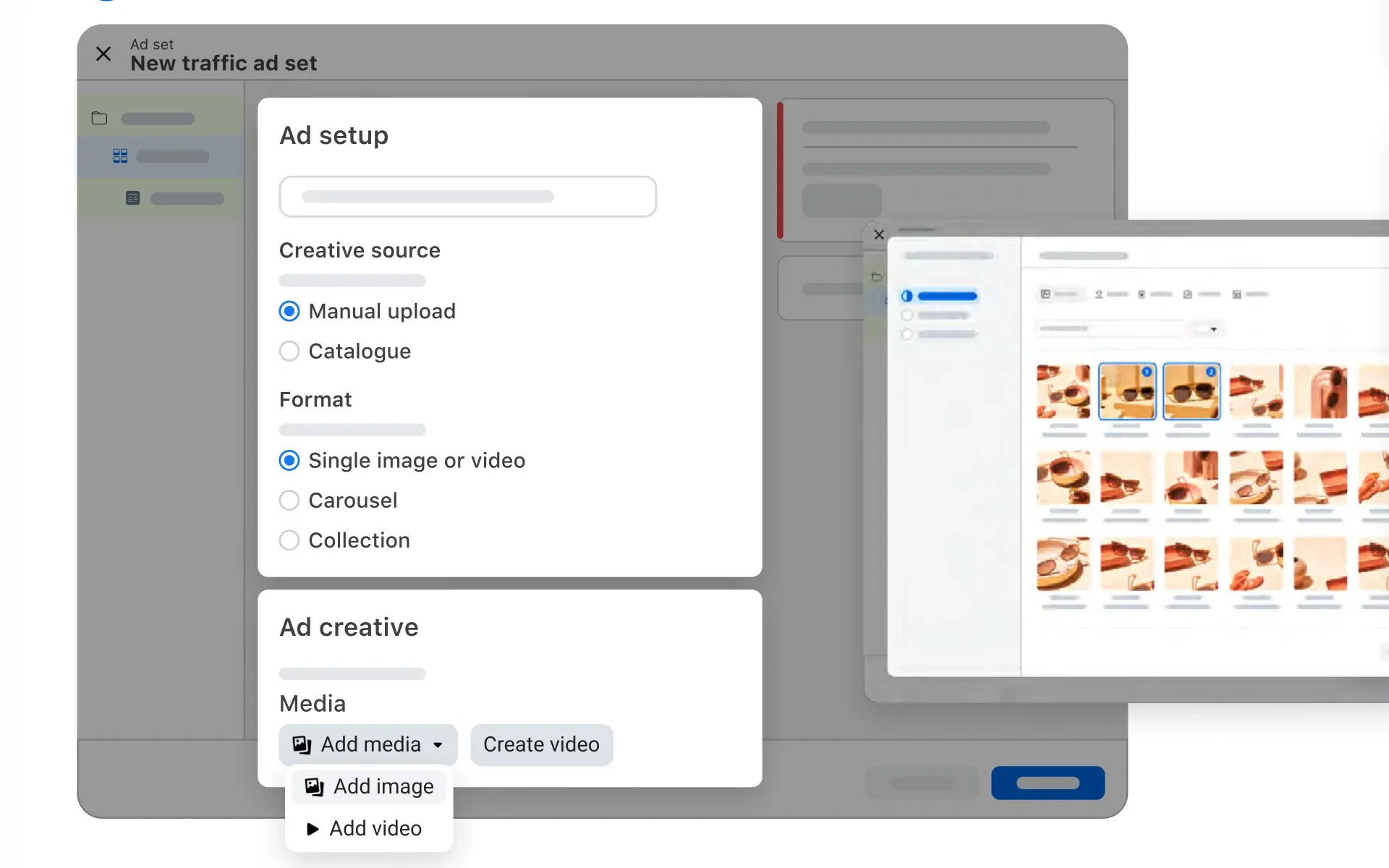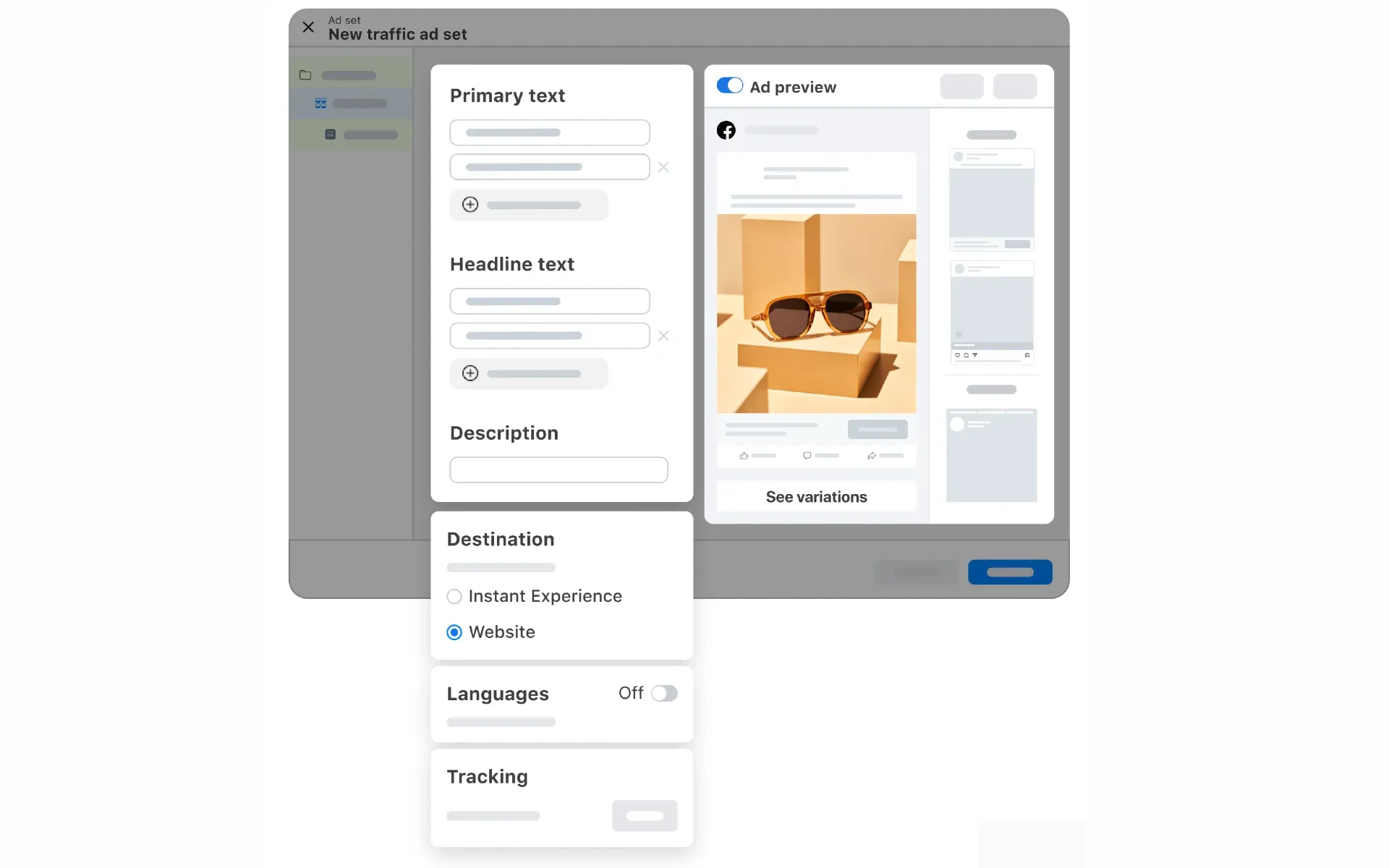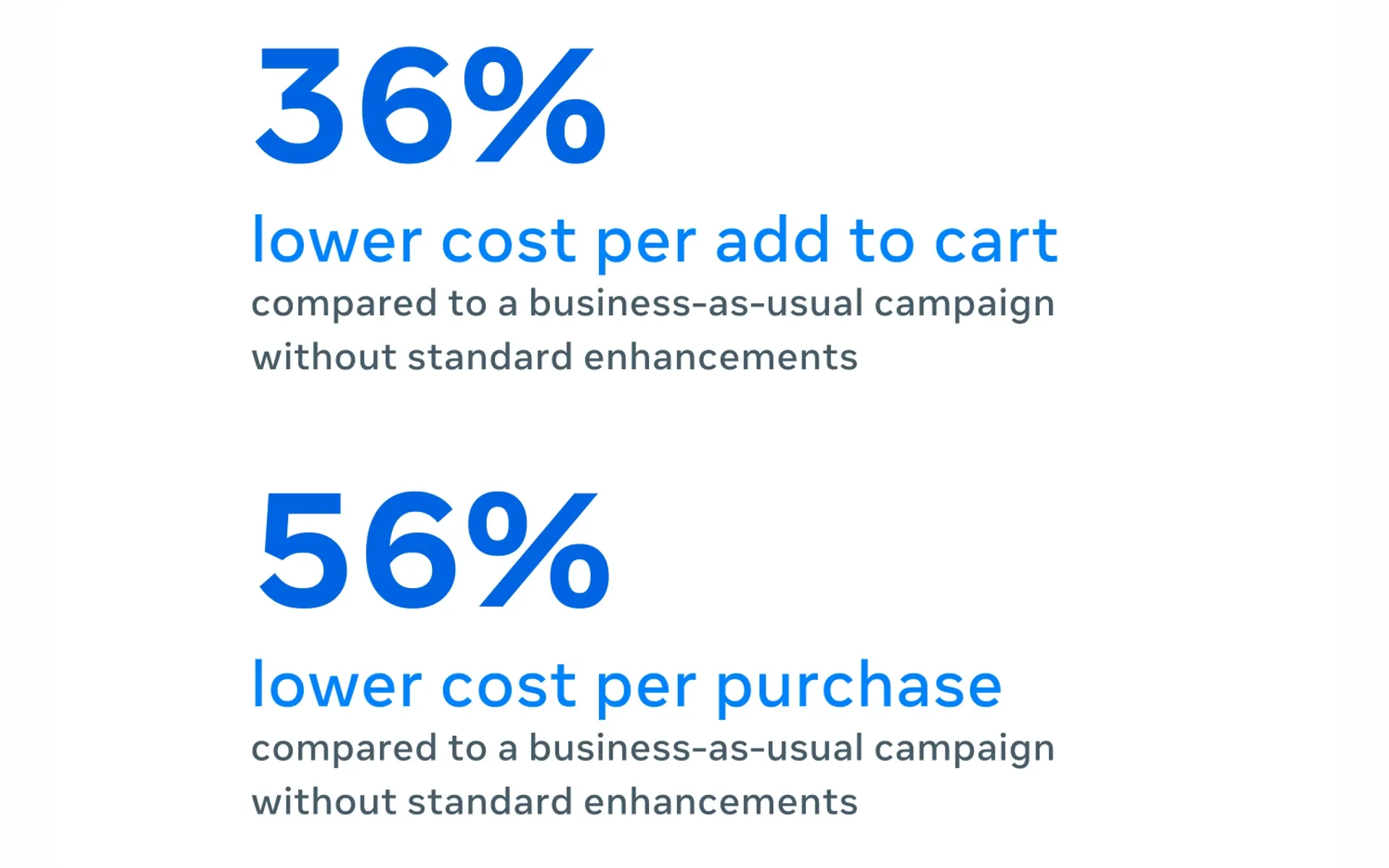Meta unveils AI-powered Video Tools for Facebook and Instagram Ads
New generative AI features Advantage+ enhance video ad creation and optimization for brands on Meta's platforms, improving engagement and performance.

On October 8, 2024, just five days ago, Meta, the parent company of Facebook and Instagram, unveiled a groundbreaking suite of generative AI video advertising tools. These innovative features, designed to revolutionize how advertisers create and optimize video content, are set to roll out in Advantage+ creative and will be widely available to advertisers in early 2025.
This development marks a significant milestone in the evolution of digital advertising, promising to reshape how brands engage with their audiences across Meta's platforms.
The New AI-Powered Video Tools
According to Meta's announcement, the new AI-powered toolkit includes two key features: Video Expansion and Image Animation.
Video Expansion represents a leap forward in video ad creation, allowing advertisers to create more immersive video ads by leveraging AI to generate unseen pixels in each frame, effectively expanding the dimensions of the video. This technological advancement aims to make ads feel more native to the platforms' viewing experience, potentially increasing user engagement and ad effectiveness.
Image Animation, on the other hand, addresses a common challenge faced by advertisers with limited video resources. This tool enables advertisers to add dynamic movement to static images on Instagram Reels, effectively turning still photos into eye-catching video content. By eliminating the need for original video assets, this feature democratizes video advertising, making it accessible to businesses of all sizes and resource levels.
The Rise of Video Content on Meta Platforms
The introduction of these tools comes at a critical juncture in the social media landscape, where video content has become increasingly dominant. Meta's internal data paints a clear picture of this trend: audiences are spending significantly more time watching Instagram Reels compared to Stories or videos in Feed. Furthermore, over half of Instagram accounts interact with a Reel at least once per week, underscoring the format's growing popularity and potential for advertisers.
Meta's decision to focus on AI-generated video tools is not merely a response to current trends but is backed by compelling data from their own research. According to a Meta analysis of global brand campaigns, Reels consistently outperformed both Feed and Stories in three crucial metrics: ad recall, favorability, and action intent. This data suggests that video content, particularly in the Reels format, is becoming increasingly important for advertisers looking to make a lasting impact on their target audience.
Enhancing Brand Voice and Tone
The implications of these new tools extend beyond mere content creation. Meta is also testing advanced capabilities to improve brand voice and tone in AI-powered creative. This includes a sophisticated tool with voice prompt capabilities, allowing advertisers to fine-tune the textual elements of their ads. Additionally, advertisers can now upload their brand logo to guide AI-created visual assets, ensuring better alignment with their brand identity and maintaining consistency across campaigns.
Meta's Broader AI Strategy in Advertising
These new video tools are part of Meta's broader strategy to integrate AI deeply into its advertising ecosystem. In May 2024, the company had already made significant strides in this direction by rolling out generative AI tools focused on image manipulation. These tools allowed advertisers to resize images, change backgrounds, and repurpose existing images to create multiple versions of ads. The success of these earlier initiatives likely paved the way for the more ambitious video-focused tools announced this month.
Improving Creator Partnerships
Meta is also focusing on improving partnerships between brands and creators, recognizing the growing importance of influencer marketing. The company unveiled a tool to create more integrated creator campaigns, allowing advertisers to seamlessly incorporate creator content into collections ads on Reels and other placements. This feature is managed through Advantage+ Catalog, aiming to make influencer collaborations more efficient and effective.
To further streamline the process of managing creator partnerships, Meta has introduced a new Partnership Ads Hub. This centralized platform allows advertisers to manage all aspects of their creator campaigns in one place, from setting up partnership ads to monitoring performance. By simplifying the management of these collaborations, Meta is positioning itself as a key facilitator in the influencer marketing ecosystem.
Partnership Ads Hub
The Impact on Advertisers
Meta's push towards AI-powered advertising solutions comes at a time when businesses are increasingly looking for ways to create engaging content efficiently and at scale. According to Chris Wood, a seasoned reporter at Search Engine Land, while fixed images work well for down-funnel advertising and are simpler to scale with existing AI tools, video is considered superior for telling brand stories at the top of the funnel. Meta's new AI video tools aim to bridge this gap, allowing advertisers to engage in sophisticated video creation with minimal additional resources.
The Video Expansion feature, in particular, is designed to ensure brand videos look native, professional, and enticing on Meta platforms. This could potentially level the playing field for businesses of all sizes, allowing them to create engaging video content that resonates with their target audience without the need for extensive resources or technical expertise.
Best Practices for Video Content Creation
For businesses looking to leverage these new tools, Meta provides guidance on creating effective video content. They recommend:
- Keeping videos vertical (9:16 or 4:5 aspect ratio) to optimize for mobile viewing.
- Limiting video length to less than 15 seconds to maintain viewer engagement.
- Capturing attention within the first 3 seconds to hook the viewer.
- Including a clear call to action to guide the viewer's next steps.
- Focusing on the brand, product, or service to reinforce the message.
These best practices are designed to help advertisers make the most of the new AI-powered tools and create video content that performs well on Meta's platforms.
Creative Ideas for Video Content
Meta also offers suggestions for businesses unsure about what to create videos about. Some ideas include:
- Putting a face to the business through interviews with team members.
- Showing the process of creating products or services.
- Creating a video series around a theme that resonates with customers.
- Giving tours of physical locations.
- Highlighting product details.
- Demonstrating products or services in action.
- Providing sneak peeks of upcoming offerings.
These ideas can serve as a starting point for businesses looking to diversify their video content and take full advantage of the new AI-powered tools.
Setting Up Ads with AI-Powered Tools
To set up ads using these new AI tools, advertisers can follow a step-by-step process in Meta Ads Manager:
- Create a new campaign with objectives like Traffic, Engagement, Leads, App promotion, or Sales.
- Set up the ad set with Advantage+ placements for best results.
- Upload creative assets (images or videos).
- Toggle on the standard enhancements feature within Advantage+ creative to access the AI-powered optimizations.
This process is designed to be user-friendly, allowing advertisers of all experience levels to take advantage of the new AI capabilities.
Standard Enhancements in Advantage+ Creative
The standard enhancements feature in Advantage+ creative is a key component of Meta's new AI-powered advertising tools. This feature automatically creates multiple variations of an ad and shows a more personalized version to each person based on what they're most likely to respond to.
Standard enhancements may make the following changes to ad creative:
Media Enhancements
- Adjusting image brightness and contrast.
- Applying artistic filters (sharpening, color temperature adjustment, vignette or radial blur).
- Varying the aspect ratio of images for both mobile-friendly (9:16 and 4:5) and horizontal viewing (1:1, 5:4).
- Adding templates to Feed images.
Ad-level Compositional Changes
- Adding labels to highlight helpful aspects of the business from the Facebook Page (likes, ratings, etc.).
- Displaying relevant Facebook comments below the ad.
The process works as follows
- Advertisers add an image or video and a variety of text options.
- Meta automatically creates variations of the ad with different text combinations, media enhancements, and compositional changes.
- Based on Meta's data, each person is shown the variation they're most likely to respond to.

Benefits of Standard Enhancements
Meta's research has shown significant benefits from using standard enhancements:
- In a large-scale advertiser study, ads using standard enhancements achieved a 4% reduction in cost per result in campaigns optimizing for link clicks, landing page views, and off-site conversions.
- Ads that were opted into standard enhancements delivered 14% more incremental purchases per money spent compared to ads that did not use standard enhancements.
These results demonstrate the potential of AI-powered optimizations to improve ad performance and efficiency.
Tracking Performance
For tracking performance, Meta notes that advertisers will be able to see aggregate performance metrics of all delivered variations in Ads Manager. However, there won't be a breakdown by format or ad creative variation. This approach allows advertisers to focus on overall performance while the AI handles the specifics of optimization.
Case Study
The effectiveness of these new tools is demonstrated by a case study from Italian fashion retailer Miriade. Using standard enhancements within Advantage+ creative, Miriade's campaign achieved impressive results:
- 36% lower cost per add to cart compared to a business-as-usual campaign without standard enhancements.
- 56% lower cost per purchase compared to a business-as-usual campaign without standard enhancements.

Davide Basile, Chief Digital Officer at Miriade, commented on their experience: "We wanted a way to optimise our ad campaigns for stronger performance and efficiency, so we were excited to test the standard enhancements feature. Having access to Meta's most advanced automation and machine learning technology enabled us to tailor the ad creative for each viewer. The strong campaign results that we saw proved it to be a winning strategy."
This case study highlights the potential of AI-powered advertising tools to significantly improve campaign performance and reduce costs for advertisers.
The Future of Video Advertising on Meta Platforms
As these new AI-powered video tools become available, they have the potential to significantly impact how businesses approach advertising on Meta's platforms. By making video creation more accessible and efficient, these tools could level the playing field for businesses of all sizes, allowing them to create engaging video content that resonates with their target audience.
The success of these tools could potentially reshape the landscape of digital advertising on Facebook and Instagram, making video advertising more accessible and effective for a broader range of businesses. As the tools roll out and become widely available in early 2025, the advertising industry will be watching closely to see how they perform in real-world applications.
Reels: The Rising Star of Meta's Video Content
The focus on Reels in Meta's new AI-powered tools is not coincidental. Reels have become a central part of Meta's strategy to compete in the short-form video space. Here are some key facts about Reels:
- Audience Engagement: Over half of Instagram accounts interact with a Reel at least once per week.
- Time Spent: Users spend more time watching Instagram Reels than Stories or videos in Feed.
- Performance Metrics: Reels outperform Feed and Stories in ad recall, favorability, and action intent.
These statistics underscore the importance of Reels in Meta's advertising ecosystem and explain why the company is investing heavily in tools to help advertisers create compelling Reels content.
Creating Effective Reels: Tips and Tricks
For businesses looking to leverage Reels in their advertising strategy, Meta offers several tips:
- Keep it Vertical: Use a 9:16 or 4:5 aspect ratio to optimize for mobile viewing.
- Be Concise: Aim for videos less than 15 seconds long.
- Hook Early: Capture attention within the first 3 seconds.
- Clear Call-to-Action: Include a clear CTA to guide viewer action.
- Brand Focus: Keep the focus on your brand, product, or service.
Additionally, businesses can consider the following content ideas for their Reels:
- Behind-the-Scenes: Show the process of creating your products or services.
- Team Spotlights: Introduce team members to put a face to your brand.
- Product Demos: Showcase your products in action.
- Customer Testimonials: Feature satisfied customers sharing their experiences.
- Trend Participation: Join in on popular trends or challenges relevant to your brand.
By following these tips and exploring various content ideas, businesses can create engaging Reels that resonate with their audience and take full advantage of Meta's new AI-powered tools.
The Role of AI in Meta's Advertising Ecosystem
The introduction of these AI-powered video tools is part of a larger trend in Meta's approach to advertising. AI is increasingly being used to optimize various aspects of ad creation and delivery:
- Creative Optimization: AI helps create multiple versions of ads tailored to individual users.
- Audience Targeting: AI algorithms help identify the most relevant audience for each ad.
- Bid Optimization: AI adjusts bids in real-time to maximize ad performance.
- Performance Prediction: AI models predict the likelihood of user actions, helping to optimize ad delivery.
As AI continues to evolve, we can expect to see even more sophisticated applications in Meta's advertising tools, potentially revolutionizing how businesses approach digital marketing on these platforms.
The Importance of Mobile-First Video Advertising
Meta's focus on vertical video formats and mobile-friendly content reflects the broader trend towards mobile-first advertising. With the majority of social media consumption happening on mobile devices, creating content that looks and feels native to these platforms is crucial for advertisational success.
The new AI-powered tools, particularly the Video Expansion feature, are designed to help advertisers create content that feels natural and engaging on mobile devices. This approach can lead to better user experiences and, consequently, improved ad performance.
Balancing AI and Human Creativity
While these new AI tools offer powerful capabilities, it's important to note that they are designed to enhance, not replace, human creativity. Advertisers will still need to provide the initial creative assets and strategic direction for their campaigns. The AI tools then optimize and personalize these inputs to create more effective ads.
This balance between human creativity and AI optimization is likely to be a key factor in the success of advertising campaigns moving forward. Advertisers who can effectively leverage both elements will be well-positioned to create compelling, high-performing campaigns on Meta's platforms.
Looking Ahead: The Future of AI in Advertising
As these new AI-powered video tools roll out and become widely adopted, they are likely to set new standards for digital advertising. We may see several developments in the near future:
- More Personalized Ad Experiences: As AI gets better at understanding individual user preferences, ads could become increasingly tailored to each viewer.
- Automated A/B Testing: AI could automate the process of testing different ad variations, continuously optimizing campaigns in real-time.
- Cross-Platform Optimization: AI tools might eventually be able to optimize ad content across different platforms and formats simultaneously.
- Enhanced Predictive Analytics: AI could provide more accurate predictions of campaign performance, helping advertisers make better strategic decisions.
- Integration with Other Marketing Tools: We might see deeper integration between Meta's AI advertising tools and other marketing technologies, creating more comprehensive, data-driven marketing ecosystems.
As these technologies continue to evolve, they have the potential to dramatically reshape the digital advertising landscape, offering new opportunities and challenges for businesses of all sizes.
Conclusion
Meta's introduction of AI-powered video advertising tools marks a significant milestone in the evolution of digital advertising. These tools have the potential to democratize video advertising, enhance creative capabilities, and improve ad performance across Meta's platforms.
By making sophisticated video creation and optimization accessible to businesses of all sizes, Meta is potentially leveling the playing field in digital advertising. Small and medium-sized enterprises, in particular, stand to benefit significantly from these advancements, as they can now compete more effectively with larger corporations in the digital advertising space.
However, the effectiveness of these tools will ultimately depend on how advertisers use them. While AI can optimize and personalize content, the core message and creative direction still need to come from the advertisers themselves. Successful campaigns will likely be those that strike the right balance between leveraging AI capabilities and maintaining a strong, authentic brand voice.
As these tools roll out and become widely available in early 2025, the advertising industry will be watching closely to see how they perform in real-world applications. The success or failure of these tools could have far-reaching implications not just for Meta and its advertisers, but for the future direction of the entire digital advertising ecosystem.
Key Facts
Meta introduced new generative AI video advertising tools on October 8, 2024.
The tools include Video Expansion and Image Animation features.
Video Expansion generates unseen pixels to expand video dimensions.
Image Animation adds movement to static images on Instagram Reels.
Over half of Instagram accounts interact with a Reel at least once per week.
Meta analysis shows Reels outperform Feed and Stories in ad recall, favorability, and action intent.
The new tools will be widely available to advertisers in early 2025.
Meta is also testing capabilities to improve brand voice and tone in AI-powered creative.
A new Partnership Ads Hub has been created to help manage creator campaigns.
The tools aim to help advertisers create engaging video content with minimal resources.
Standard enhancements in Advantage+ creative can lead to significant improvements in ad performance.
Miriade, an Italian fashion retailer, achieved 36% lower cost per add to cart and 56% lower cost per purchase using standard enhancements.

